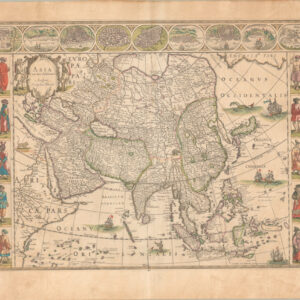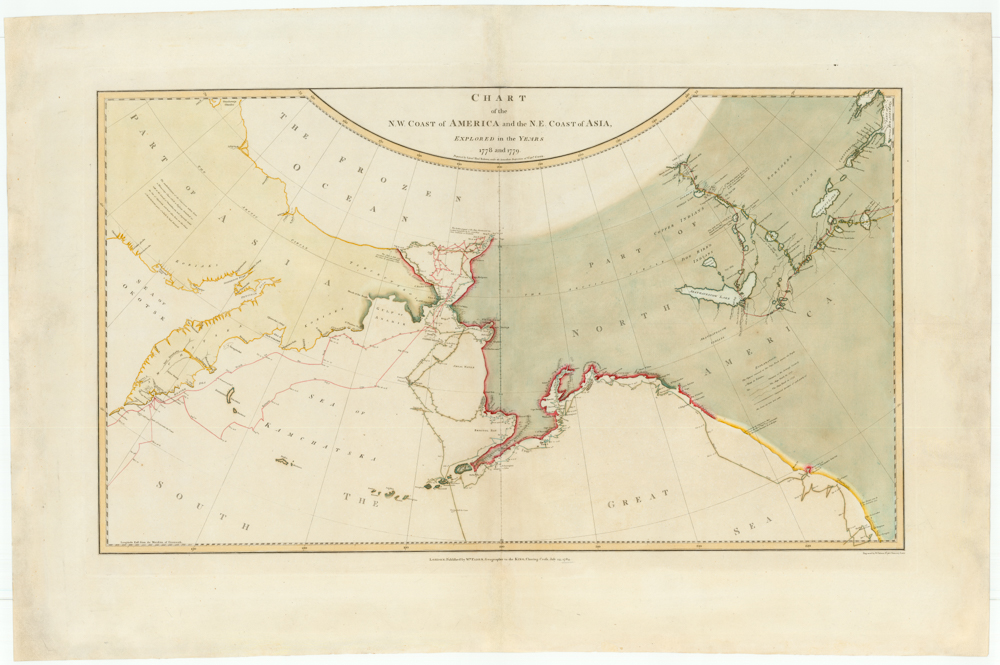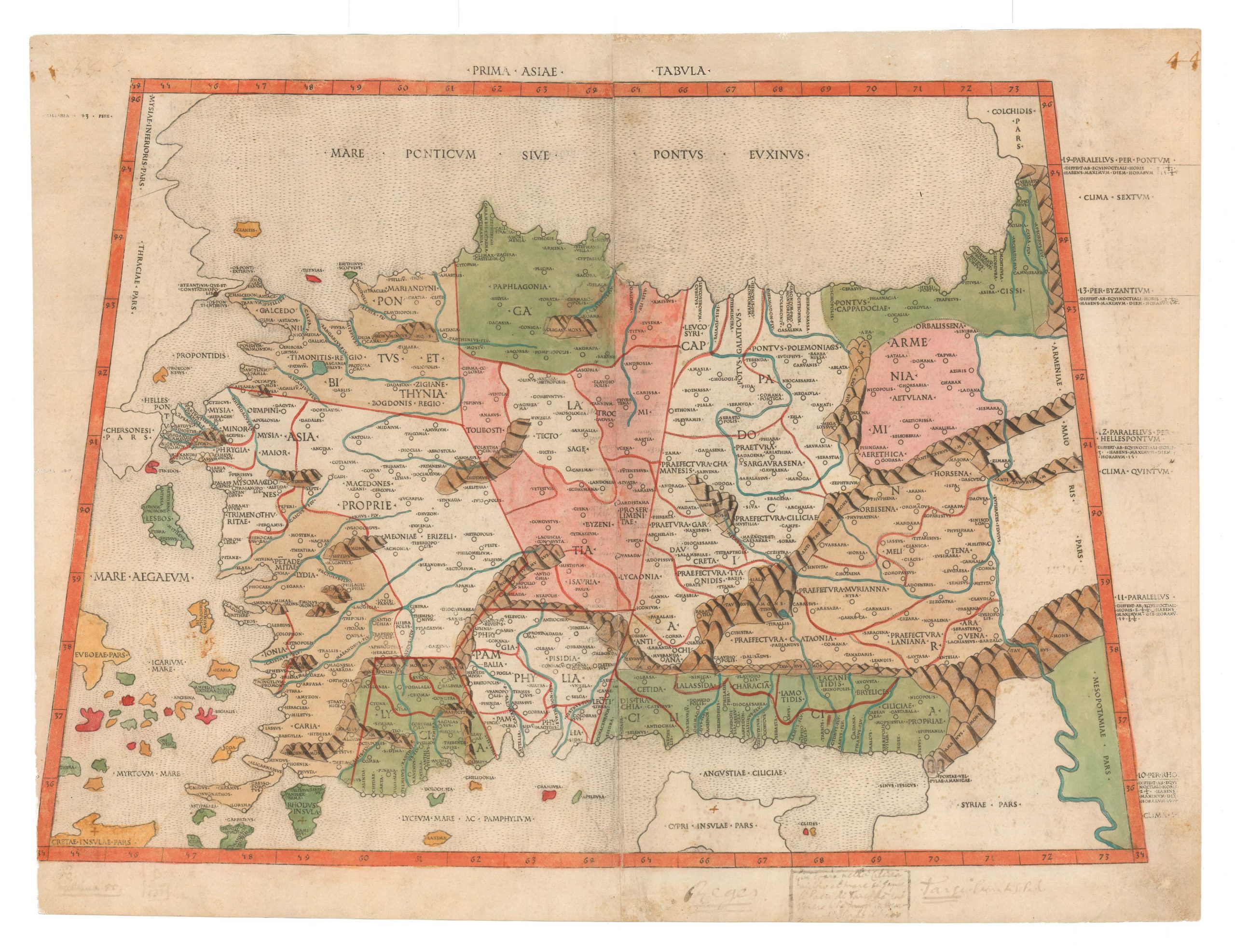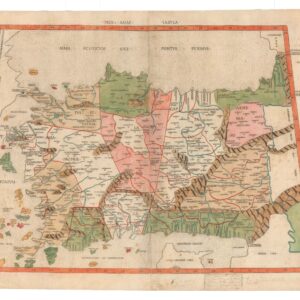One of the rarest sets from the Golden Age of celestial cartography.
Globi coelestis in tabulas planas redacti descriptio, auctore R. P. Ignatio Gastone Pardies Societatis Jesu mathematico. Opus postumum
$15,500
1 in stock
Description
Three aspects make this set especially desirable:
- It contains a rare celestial chart of the Southern Hemisphere, a product of Pardies’s access to new sets of astronomical observations from expeditions there. We see new constellations, many of which are the direct products of Frederick Houtman’s observations in the South Seas.
- Pardies used an innovative gnomonic projection, standing in stark contrast to the Mercator projection, which dominated terrestrial mapmaking by the late 17th century. Rather than keeping meridians straight, a gnomonic projection essentially bends the latitudinal meridians to create a circular field of rendition.
- Celestial map historian Nick Kanas (p. 176) notes that: “an important feature of Pardies’ atlas was the inclusion of the paths through the constellations of a number of historically important comets,” which Pardies likely sourced from an influential cometary book by Lubieniecki, published in 1666-8.
The Decisive Second Edition
The first edition of Pardies’s work was published in 1674. It became hugely influential in a field in constant growth, so much so that his protégés soon concluded that a second revised edition was warranted. This edition was printed in 1693 and included the addition of newly discovered stars to the original charts and updates in the associated texts. Kanas (p. 176) notes that this second edition included “additional comets along with the southern stars as determined by Halley.” The six double-page charts depict more than 1500 stars, nebulae, and comets known to astronomers at the time. In most cases, these have been combined into the constellations we still know and use today.
Every chart is flanked by two bars of text. On the first chart, the content consists mainly of Pardies’s dedication, in Latin, to his patron, and is dated to 1673, the same year as his death. In the remaining five sheets, the bars consist of explanatory texts in both Latin (left margin) and French (right margin). Pardies notes that his star positions are based on the observations of Riccioli, Bayer, and Kepler and that he had included 1,481 stars, which in our second edition have been increased to more than 1500.
As an active and well-connected scientist, Pardies was well aware that with each passing month, new stars would be identified—in part driven by continuous improvements in telescope technology. To underline that this was a rapidly developing endeavor, Pardies ended his treatise with the latest astronomical observations. His work became so influential that for decades following its publication, Jesuit astronomers relied almost exclusively on these charts for ascertaining the correct coordinates of known celestial bodies.
Below is a brief run-through of the individual charts’ pictorial schemes, highlighting their respective importance and each chart’s distinct decorative elements. Being a product of the Age of Exploration, the charts set themselves apart by recognizing that the heavens looked different from the Southern Hemisphere. The thematic choices in compiling these new constellations reflect a European imagination constantly being challenged, stimulated, and expanded.
Plate 1: Ursa Major, Ursa Minor, Perseus, and other constellations.
The first sheet is centered on the north pole down to 45 degrees N. It views the Arctic Circle from above and provides us with a range of dramatic imagery associated with astronomical phenomena. These include the well-known constellations of Ursa Major and Minor, as well as constellations named after the pantheon of characters in Greek mythology. The latter category includes Cassiopeia, Cepheus and their daughter Andromeda, a strident Perseus carrying the screaming head of Medusa, the feet of Hercules, as well as Auriga, and the herdsman Bootes. Draco, with its hissing mouth revealing gruesome fangs and a long forked tongue, immediately catches the viewer’s attention. All of these constellations were originally identified by Ptolemy in the 2nd century.
Plate 2: Cetus, Aquarius, Andromeda.
The second sheet is centered on the vernal equinox. At top we find the constellation Andromeda extending out of the image toward the pole. Other recognizable elements include the zodiac constellations Aries and Aquarius, as well as a number of mythological beasts identifying constellations. The most dominant of these is the large central monster labeled Cetus, a reference to a baleen monster from Greek mythology; the depiction of this beast on Pardies star chart is remarkably reminiscent of the sea monsters found in 16th century maps like Ortellius’ Islandia. Running an elliptical course through Cetus’ head we find a reference to one of many comets charted in this atlas. A second comet is found a little above, and this has the recognizable label ex Tychone, or from Tycho Brahe. A poignant image that Brahe’s 1590 comet passes through is the minor constellation of Triangulum, which was one the many astronomers’ tools that Brahe developed himself. Pardies has placed an asterism of the fleur-de-lis just above Aries.
Plate 3: Gemini, Orion, Taurus and other constellations.
In sheet 3 we have shifted perspective, in that we are viewing the night sky as it appears when moving south from the Arctic along the 69th parallel — i.e. the summer solstice. Dominating the theatre are the four well-known constellations of Cancer, Gemini, Orion, and Taurus; the latter two shown poised to engage one another in heated combat. Above this scene we find the feet of both Perseus and Auriga, which allow this chart to be linked seamlessly to Sheet 1. Other constellations we might mention include the small and large dog (Canis), the timid Lepus, and Hydra looking hungrily in from the left. The plate also contains Ursa Major.
In the lower left corner is a dramatic rendition of a caravel-style ship labeled the Argo Navis. This is the one constellation included in 17th century charts that no longer exists today. Broken up out of sheer consensus, the Argo cluster was deemed too enormous to function as a viable constellation in the modern sense of the word, making Hydra the largest constellation still recognized today. A final note should be made on what almost looks like a hairy blue tentacle in the lower right of the image. This is the constellation Eridanus: the great celestial river that flows through the galaxy from water poured by Aquarius himself.
Plate 4: Virgo, Hydra and other constellations.
Sheet 4 is centered on the autumnal equinox. We have extended from the Arctic beyond the Equator along the 180th parallel; so exactly opposite to what is depicted in Sheet 2. The Bootes or herdsman figure in the upper left corner links this chart to the first polar chart, whereas the tail of Hydra and the Argo’s mast connect this sheet to Sheet 3. Among the easily recognizable constellations we find both Leo and Virgo, and upon closer inspection also most of Libra to the far left. In the bottom of the image we find one of the distinctly southern constellations, Centaur, as well as a claw of potent Scorpius. Among the minor constellations we find another couple of phenomena specifically associated with the Southern Hemisphere: Crater and Corvus (Crow).
Plate 5: Hercules, Sagittarius and other constellations.
The fifth sheet is centered on the winter solstice. Kanas (p. 177) draws our attention to an array of features: “the paths of the comets (including Halley’s comet to the upper right); Kepler’s nova in Serpentarius and the P Cygni variable labeled as a nova; the absence of Vulpecula, Sputum, and Mons Maenalus; and the two other coronae shown as wreathes.”
Sheet 5 contains a plethora of constellation imagery, many of which have only been depicted in part, their extensions finding form in the maps described above. Among the established zodiac we find a band running through the lower tier of the image. From the right to left, this includes the second half of Libra and most of Scorpio, as well as Sagittarius and Capricorn on the left. The image is abounding with other major constellations as well, although perhaps of lesser popular renown. We mentioned the feet of Hercules figuring in the polar view of Sheet 1, but most of this heroic figure, donned here in his famous lion’s skin, is seen in Sheet 5. Another equally imposing figure is the snake bearer, or Serpentarius, also known by its Latin term Ophiucus, holding the separate constellation Serpens in his arms.
Plate 6: Centaurus, Indus, Chamaeleon and other constellations.
The sixth sheet is perhaps the most interesting in that it was dedicated to the least studied region of the skies. Focused specifically and exclusively on the Southern Hemisphere, and with the South Pole at its center, this chart gave European audiences a whole new range of constellations to imagine (as most would never actually see them). The southern polar constellations were charted by Frederick Houtman during the first Dutch expedition to East India. Leading the expedition was his fellow Dutchman Pieter Dirkszoon Keyser. The Houtmann/Dirkszoon constellations include iconic clusters like the Southern Cross, Indus (American Indian), Toucan, and Peacock, all inspired by recent European voyages and their fascinating discoveries in the New World.
Cartographer(s):
Ignace-Gaston Pardies (1636-1673) was born in Pau, Southern France, as the son of a French assemblyman. He joined the society of Jesus in 1652, at age 16, and soon began his studies in classical literature, philosophy, and mathematics; subjects which he soon also taught at the prestigious secondary school Lycée Louis-le-Grand in Paris.
A true polymath, Pardies published treatises of a range of subjects including the construction of sundials, formal critiques of Galileo and Isaac Newton, and studies on optics and the theory of light. The Dutch physicist Christiaan Huygens — a father of the scientific revolution and one of the greatest scholars of his time — accredited Pardies with the theoretical observation that the speed of light had to be finite.
The work that above all caused Pardies to be remembered as a great thinker and scholar was his celestial atlas Globi coelestis in tabulas planas redacti descriptio, which was first published in 1674, and had been reissued twice by 1700. The atlas set new standards for depicting and describing astronomic observations and was the key work for generations of stargazers. Almost 200 years after its publication, in 1844, the English astronomer William Rutter Dawes drew very directly on Pardies’ atlas in compiling his own set of star charts, which themselves set new standards for the mapping of the heavens.
Pardies never lived to see his labor come to fruition, as he died two years before its publication. The final expression of the folio volume was consequently influenced by both the typesetter Sebastien Mabre-Cramoisy and the Parisian engraver Guillaume Vallet, who helped materialize Pardies’ rendition of the heavens to the highest aesthetic standards. And finally, there was, of course, the hand of Jean de Fontenay (1643-1710), a fellow Jesuit astronomer and the posthumous editor of Pardies groundbreaking work.
Condition Description
Exquisite original color. Repaired loss in the lower corner margins, not affecting images.
References
Kanas, Nick. Star Maps: History, Artistry, and Cartography. THIRD EDITION. Springer, 2019.







